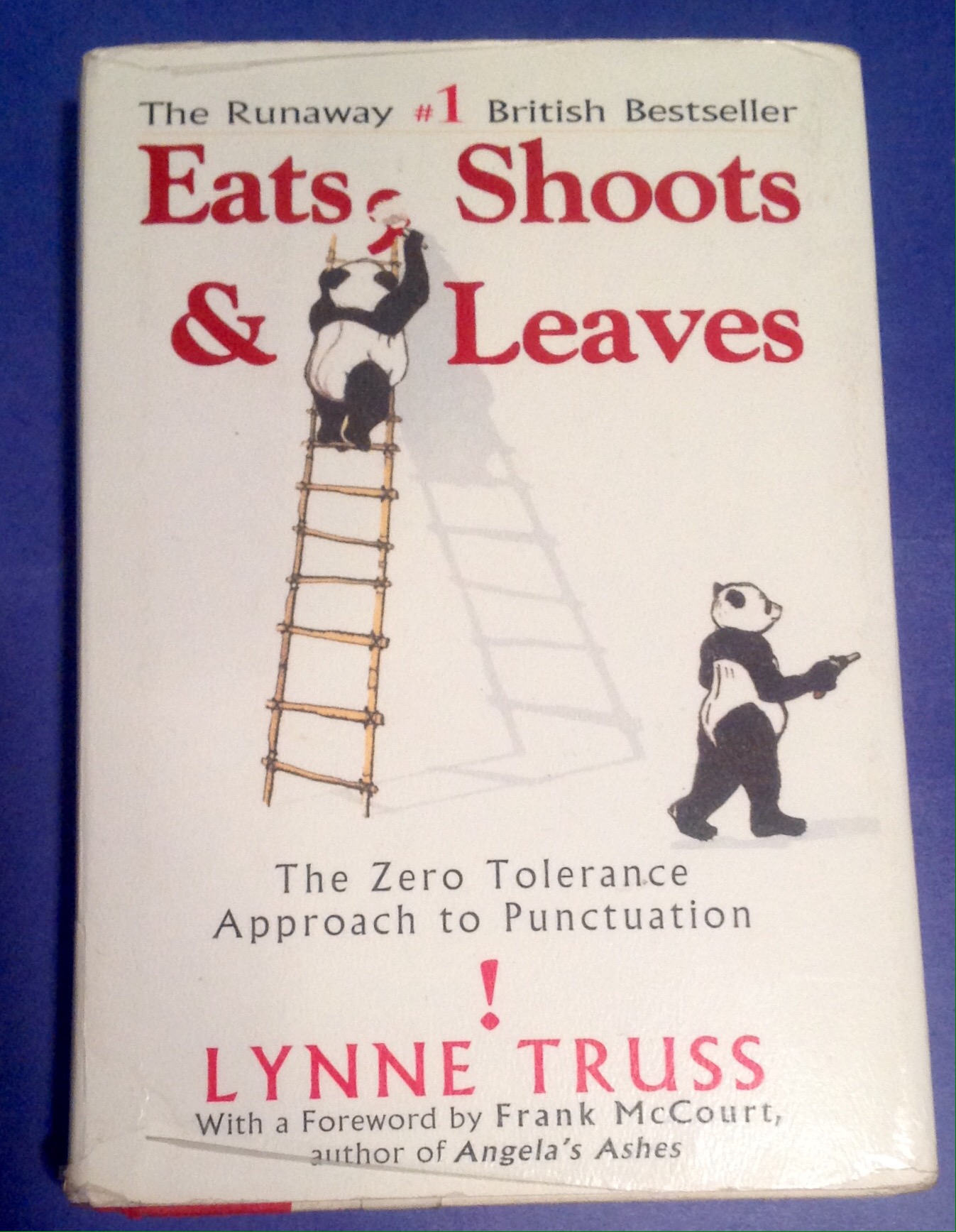A panda walks into a cafe. He orders a sandwich, eats it, then draws a gun and fires two shots in the air.
“Why?” Asks the confused waiter, as the panda makes towards the exit.The panda produces a badly punctuated wildlife manual and tosses it over his shoulder.“I’m a panda,” he says, at the door. “Look it up.”
The waiter turns to the relevant entry and, sure enough, finds the explanation.
“Panda. Large black-and-white bear-like mammal, native to China. Eats, shoots and leaves.”
“Eats, Shoots & Leaves” back jacket cover.
The subtitle to “Eats, Shoots & Leaves” is “The Zero Tolerance Approach to Punctuation.” Yes, someone wrote a book for the grammar Nazis in your life. Actually, it’s for the punctuation Nazis, but they’re close cousins. In fact, Lynne Truss, the delightful author of this little 200 page book, even describes herself as someone who wants to not only correct people’s punctuation, but inflict government sponsored harm on those who perpetuate such satanic sins as “for CD’s, VIDEO’s, DVD’s, and BOOKS’s.” If you immediately spotted what is wrong with that phrase, this book is for you. If you see nothing wrong with that phrase, this book is especially for you.
The book was originally written in Britian. By that I mean that it was written by people who take language much more seriously than we Americans tend to. But, it suffers not the least for being written in a foreign language. The American version seems to work just fine.
Before you jump into the actual text of the subtle nuances of apostrophes, commas, colon (semi and full) and question marks, be sure to read the introductory material: the forwards and prefaces. Truss talks about the surprising success of “Eats, Shoots & Leaves.” Who would have predicted that a book about punctuation would become a best seller? As a writer, I can understand the motivtion to write a book that won’t be popular. Not every book is destine to be the next “Harry Potter.” And, many authors create books that are a labor of love.
I have a book in library that discusses the infrared (IR) spectrum and how you can use it to communicate between computers. Before Bluetooth, we had IR. If you remember having to point the TV remote exactly at the right spot on the television to change the channel, you were probably using an IR remote. There were a lot of problems with IR. It had a limited range. Communication was impossible in sunshine. It had to have directly line-of-sight. It was an extremely secure, but that was not enough of an advantage to make it very popular. My friend, however, wrote an entire book on the protocol. He knew when he wrote it that the book would not sell a lot of copies. But, he was an author and IR was his passion.
Punctuation was Truss’ passion. And that passion comes through in her writing. Fortunately, she also has a great sense of humor and sense of the absurd. That also comes through in her writing. “Eats, Shoots & Leaves” is a delightful book. Whether you are a grammar (punctuation) Nazi or simply a casual reader. The book flows effortlessly from one topic to the next and you will find examples, good and bad, of your own writing and certainly of those writing around you.
What I Liked
I enjoyed every aspect of this book. Truss gives not just current usage rules, but historical context for some of our punctuation marks, and the writing process in general. Her voice is mildly self-deprecating in a way that makes you suspect that she knows how silly arguments about punctuation can be, but she’s going to pretend it’s deadly serious stuff. She covered apostrophes, commas, dashes, colons, semi-colons, the exclamation mark and even the question mark. I don’t know that my own writing has improved as a result of reading “Eats, Shoots & Leaves,” but I at least understand better that I’m butchering our mother tongue.
What I Didn’t
Honestly, there is very little that I didn’t like. Perhaps she could have delved into the history and usage of parenthesis, or braces, or the tilde. But, “Eats, Shoots & Leaves” does exactly what it sets out to do, give some context to our use, and misuse of those little printer marks that keep the words from running together on the page.
What It Means To You
If you are a writer, you will enjoy this book. If you are an editor, you will love this book. If you have ever walked past a sign and thought, “Is that how you use an apostrophe?” you will enjoy this book.
My Rating
Four out of four stars.
Rodney M Bliss is an author, columnist and IT Consultant. His blog updates every weekday at 7:00 AM Mountain Time. He lives in Pleasant Grove, UT with his lovely wife, thirteen children and grandchildren.
Follow him on
Twitter (@rodneymbliss)
Facebook (www.facebook.com/rbliss)
LinkedIn (www.LinkedIn.com/in/rbliss)
or email him at rbliss at msn dot com(c) 2016 Rodney M Bliss, all rights reserved
